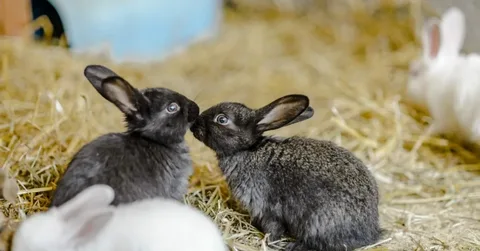Significance of Studying Reproductive Behaviors
Understanding the reproductive behaviors of rabbits provides valuable insights into their evolutionary adaptations, social dynamics, and ecological roles. By studying mating rituals, nesting behaviors, and reproductive cycles, researchers can uncover the underlying mechanisms driving rabbit reproduction and develop strategies for managing captive breeding programs and conserving wild populations.
Mating Rituals
Courtship Displays
Mating rituals in rabbits often begin with elaborate courtship displays, where males seek to attract the attention of females through a series of behaviors. These behaviors may include circling, chasing, and nuzzling, as well as vocalizations and scent marking to establish dominance and reproductive readiness.
Copulation
Once a male successfully courts a female, copulation occurs, typically lasting only a few seconds but essential for fertilization to take place. During copulation, the male mounts the female from behind and quickly ejaculates, depositing sperm into the female’s reproductive tract.
Nesting and Parental Care
Nest Building
After mating, pregnant females exhibit nesting behaviors, preparing a safe and cozy nest for their impending offspring. They gather materials such as straw, grass, and fur to construct the nest, often hidden in a secluded spot to protect the vulnerable kits from predators and adverse weather conditions.
Nursing and Grooming Offspring
Once the kits are born, the mother provides essential care, including nursing and grooming. Rabbit milk is highly nutritious, rich in fat and protein, and crucial for the growth and development of the young. The mother also spends time grooming her offspring, stimulating their circulation, and removing any dirt or debris from their fur.
Reproductive Cycles
Estrus and Fertility
Female rabbits, known as does, are polyestrous, meaning they experience multiple estrous cycles throughout the year. Each estrous cycle consists of several stages, including proestrus, estrus, metestrus, and diestrus, with ovulation occurring during estrus when the female is most fertile and receptive to mating.
Gestation Period
The gestation period in rabbits typically lasts between 28 to 31 days, depending on factors such as breed, age, and environmental conditions. During this time, the developing embryos receive nutrients and oxygen from the mother’s bloodstream through the placenta, culminating in the birth of a litter of kits.
Factors Influencing Reproduction
Environmental Conditions
Environmental factors such as temperature, humidity, and photoperiod can influence rabbit reproduction. Rabbits are sensitive to changes in their environment, with extremes in temperature or disturbances in their habitat potentially disrupting their breeding cycles and reproductive success.
Social Dynamics
Social interactions within rabbit colonies can also impact reproductive behaviors. Dominant individuals may monopolize access to mates and resources, while subordinate rabbits may struggle to reproduce successfully. Social stressors such as overcrowding or aggressive behavior can further disrupt breeding patterns and fertility rates.
Human Intervention and Breeding Practices
Selective Breeding
Humans have selectively bred rabbits for various traits such as size, color, and temperament, shaping their reproductive behaviors over generations. Breeding programs aim to produce rabbits with desirable characteristics for purposes such as meat production, fur quality, and pet ownership.
Reproductive Health Management
In captive settings, proper reproductive health management is essential for maintaining breeding stock and ensuring the welfare of the animals. This includes regular health checks, vaccination protocols, and genetic screening to prevent hereditary diseases and optimize reproductive success.
Conclusion
In conclusion, the reproductive behaviors of rabbits are diverse and intricate, reflecting their evolutionary adaptations and ecological roles as prolific breeders. By studying mating rituals, nesting behaviors, and reproductive cycles, researchers gain valuable insights into the mechanisms driving rabbit reproduction and develop strategies for managing captive breeding programs and conserving wild populations.
FAQs (Frequently Asked Questions)
- How many kits can a rabbit have in a litter? The number of kits in a rabbit litter can vary depending on factors such as the age, health, and breed of the doe. On average, a rabbit can have anywhere from 4 to 12 kits in a single litter, although larger litters are possible in some cases.
- At what age can rabbits start breeding? Rabbits reach sexual maturity at different ages depending on their breed and individual development. Generally, rabbits can start breeding as early as 4 to 6 months old, although it’s recommended to wait until they are at least 6 to 8 months old to ensure optimal health and fertility.
- How long does it take for rabbit kits to open their eyes? Rabbit kits are born blind and with their eyes closed, and they typically begin to open their eyes between 7 to 10 days after birth. By the time they are 2 weeks old, most kits will have their eyes fully open and be more mobile and active.
- Do male rabbits play a role in caring for the offspring? Male rabbits, known as bucks, generally do not play a direct role in caring for the offspring. However, they may provide protection to the female and her kits and participate in territorial defense to ensure their safety.
- What are some common health concerns during rabbit pregnancy? Common health concerns during rabbit pregnancy include dietary imbalances, uterine infections, and complications during birth. It’s essential to monitor the doe closely during pregnancy and seek veterinary care if any signs of illness or distress arise.
